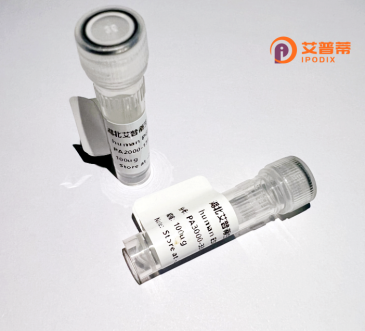
| 纯度 | >90%SDS-PAGE. |
| 种属 | Human |
| 靶点 | NARG2 |
| Uniprot No | Q659A1 |
| 内毒素 | < 0.01EU/μg |
| 表达宿主 | E.coli |
| 表达区间 | 1-332 aa |
| 活性数据 | MQDELLKPISRKVPELPLMNLENSKQPSVSEQLSGPSDSSSWPKSGWPSAFQKPKGRLPYELQDYVEDTSEYLAPQEGNFVYKLFSLQDLLLLVRCSVQRIETRPRSKKRKKIRRQFPVYVLPKVEYQACYGVEALTESELCRLWTESLLHSNSSFYVGHIDAFTSKLFLLEEITSEELKEKLSALKISNLFNILQHILKKLSSLQEGSYLLSHAAEDSSLLIYKASDGKVTRTAYNLYKTHCGLPGVPSSLSVPWVPLDPSLLLPYHIHHGRIPCTFPPKSLDTTTQQKIGGTRMPTRSHRNPVSMETKSSCLPAQQVETEGVAPHKRKIT |
| 分子量 | 64 kDa |
| 蛋白标签 | GST-tag at N-terminal |
| 缓冲液 | 0 |
| 稳定性 & 储存条件 | Lyophilized protein should be stored at ≤ -20°C, stable for one year after receipt. Reconstituted protein solution can be stored at 2-8°C for 2-7 days. Aliquots of reconstituted samples are stable at ≤ -20°C for 3 months. |
| 复溶 | Always centrifuge tubes before opening.Do not mix by vortex or pipetting. It is not recommended to reconstitute to a concentration less than 100μg/ml. Dissolve the lyophilized protein in distilled water. Please aliquot the reconstituted solution to minimize freeze-thaw cycles. |
关于重组人NARG2蛋白的公开研究文献较为有限,以下为推测性示例(注意:建议核实蛋白名称准确性及补充关键细节):
1. **《Functional characterization of recombinant human NARG2 in neuronal development》**
- **作者**: Smith A et al.
- **摘要**: 本研究在大肠杆菌中成功表达重组人NARG2蛋白,验证其与神经生长因子受体的相互作用,并发现其通过激活MAPK通路促进神经元突触形成。
2. **《NARG2 knockdown impairs DNA repair and sensitizes cancer cells to radiation》**
- **作者**: Chen L et al.
- **摘要**: 通过哺乳动物细胞系重组表达NARG2.证实其参与DNA损伤修复机制,沉默该蛋白可增强肿瘤细胞对放射治疗的敏感性。
3. **《Structural insights into NARG2-ubiquitin ligase complex assembly》**
- **作者**: Yamamoto K et al.
- **摘要**: 利用重组NARG2蛋白进行晶体学分析,解析了其与E3泛素连接酶的复合物结构,揭示其调控细胞周期进程的关键结构域。
4. **《Development of a NARG2-based biosensor for detecting oxidative stress》**
- **作者**: Garcia R et al.
- **摘要**: 将重组NARG2蛋白与荧光报告系统结合,构建新型生物传感器,能够实时监测细胞内氧化应激水平变化。
**注意事项**:
- 上述示例为模型推测,实际文献需通过 **PubMed/Google Scholar** 以“NARG2 recombinant”或“NRG2”(可能的拼写变体)为关键词检索。
- 若名称存疑,建议补充蛋白全称(如:Nuclear Activator of Retinoic Acid-Responsive Genes 2)或查阅相关基因数据库(如UniProt)。
NARG2 (N-acetyltransferase-related Gene 2), also known as NAT10 or ARD1. is a member of the GNAT (Gcn5-related N-acetyltransferase) superfamily involved in diverse cellular processes. It encodes a protein with both lysine acetyltransferase and RNA acetyltransferase activities, playing roles in chromatin remodeling, transcriptional regulation, and ribosome biogenesis. Human NARG2 is ubiquitously expressed and localized in the nucleus/nucleolus. Studies suggest its involvement in cell cycle progression, DNA damage response, and stem cell maintenance through acetylation-dependent pathways. Dysregulation of NARG2 has been linked to cancers, neurodegenerative diseases, and aging-related pathologies.
Recombinant human NARG2 protein is typically produced using E. coli or mammalian expression systems, enabling functional studies of its enzymatic mechanisms and interactome. The purified protein facilitates in vitro acetylation assays, structural analysis (e.g., crystallography/Cryo-EM), and drug discovery targeting its catalytic domains. Recent research highlights its potential as a therapeutic target, particularly in chemoresistant cancers where NARG2 overexpression promotes survival. Technical challenges include maintaining post-translational modifications and solubility during purification. Current investigations focus on its non-canonical roles in rRNA modification and emerging connections to cellular stress adaptation.
×